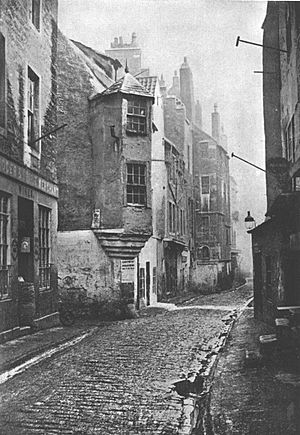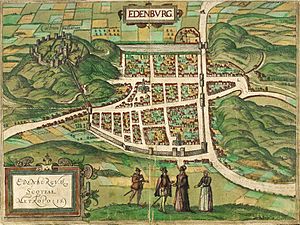Entry of Mary, Queen of Scots, into Edinburgh facts for kids
On 19 August 1561, the 18-year-old Mary, Queen of Scots, returned to Scotland from France following the death of her husband King Francis II of France the previous winter. On 2 September the town of Edinburgh organised a celebration of royal entry for her.
Events
Tailors and "boys" made black mourning "dule" riding cloaks and skirts for Mary, Queen of Scots, and her 15 ladies. Mary wore black Florence serge, the other costumes were made from 50 ells of cheaper black stemming.
On the day, Mary rode from Holyrood Palace to Edinburgh Castle where she had dinner. After the meal, she went to the Castlehill on the High Street and joined an escort of 50 young men from Edinburgh who were dressed as "Moors", a disguise representing imagined African people, with rings in their mouths and gilded chains about their necks and arms. The costumes of some of this "Convoy of Moors" were made of white taffeta. A 16th-century chronicle called the Diurnal of Occurents describes their costume, black face, and chains in Scots language:
thair bodeis and theis [thighs] coverit with yeallow taffiteis, thair armis and leggs from the knee doun bare, cullorit with blak, in maner of Moris, upon thair heidds blak hattis, and on thair faces blak visouris, in thair mowthis rings, garnessit with intellable [set with innumerable] precious staneis, about thair nekkis leggs and armes infynit of chenis of gold.
Mary made her progress under a "paill" or canopy of purple velvet with gold fringes held up by twelve townsmen dressed in black velvet. At the Butter Tron (where dairy products were weighed for sale) at the head of the West Bow there was a pageant stage. A boy dressed as an angel emerged from a globe and gave her the keys to the town, a bible, and a psalter. At the Tolbooth, on a double stage, four damsels (male actors) represented Fortitude, Justice, Temperance, and Prudence. At the Cross, wine poured from a fountain, and four maidens performed an allegory. At another stop at the Salt Tron a pageant representing the Scottish Reformation was abandoned in favour of the destruction of Korah, Dathan, and Abiram.
At the Netherbow, the boundary between Edinburgh and the Canongate, the queen was addressed by a dragon which was then burnt. At Holyrood Palace, a cartload of school children spoke in favour of the Reformation and sang a psalm. A cupboard of gilt plate, bought by the town council from the Earl of Morton and Richard Maitland of Lethington, was presented to the queen in her outer chamber in Holyrood Palace, by the "honest men" who had carried and walked beside the canopy.
Burgh records

The town council had met on 26 August and resolved to hold a banquet for the queen and her cousins, and a "triumph" of "her grace's entry within this town". The Provost of Edinburgh, Archibald Douglas of Kilspindie, discussed methods of funding the event, countering objections raised by the goldsmith Thomas Ewyn who spoke on behalf of the town's craftsmen. The treasurer, Luke Wilson, was appointed to organise the banquet and the "triumph". Wilson also supplied the costumes for the men bearing the canopy and town's sergeants. A carpenter Patrick Schang made the stages for the "triumphs and farces" at the Over or Butter Tron, Tolbooth, Cross, Salt Tron, and Netherbow. The stages were painted by Walter Binning. The young men (playing the "Moors") were expected to devise their own costumes to wear while they made "convoy before the cart triumphant". The banquet was held in Cardinal Beaton's house in the Cowgate.
Verses
The verses spoken when the boy appeared out of a globe to give gifts of books to the queen survive. The English diplomat Thomas Randolph sent a copy to William Cecil. According to John Knox, Mary smiled at verses in her praise but passed the Bible to her attendant Arthur Erskine of Blackgrange.
- Welcome our Souveraine Welcome our natyve quene
- Welcome to us your subjects greate and smalle
- Welcome I saye even from the verie spleene
- to Edinburghe youre cyttie principall
- dothe heere offer to your excellence
- two proper volumes in memoriall
- as gyftes most gainand for a godlie prince
- Wherein your grace may read and understand
- the perfyct waye unto the heavens hie
- and how to rewle your subjects and your land
- and how your kingdom established salbe
- Judgement and wysedome herein shall you see
- here shall you find that God hes done command
- and who the contrarie does wilfullie
- how them he thretines with his scurge and wand
- Ane gyfte more precious could we none present
- nor yet more nedefull for your excellence
- quhilk (which) is Gods law his word his testament
- trewlie translated with faithful diligence
- quhilk to accept with humble reverence
- the Provost present moste hartelie yow exhorts
- with the (w)hole subjects due obedience
- together with the keyse of their ports
- In sign that they and all that they possess
- bodie and goods shall ever reddie be
- to serve you as thair souveraigne hie misteris
- both daye and ever after their bound deutie
- beseching your grace in this necessetie
- their shorte tyme & gudwill consither
- accept their hearts & take it patiently
- that may done seeing all is yours together.
Civic and court drama in Scotland
The events staged at the Edinburgh Entry were closely paralleled in other festivals, including:
- The 1503 Entry of Margaret Tudor.
- The 1579 Entry of James VI into Edinburgh
- The 1590 Entry and coronation of Anne of Denmark. Further detail from this event is available for the performance of the "Convoy of the Moors".
Royal baptisms also included elements of masque, drama, and formal processions:
- The 1566 Baptism of James VI
- The 1594 Masque at the baptism of Prince Henry



